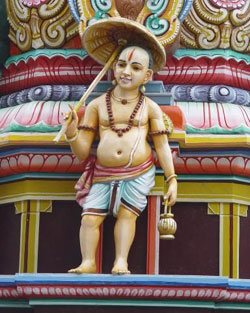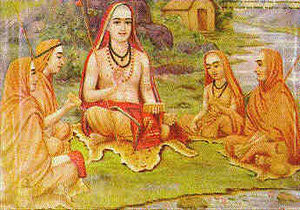 |
 |
 |
 |
| Volume 4 - Issue 06 JUNE 2006 |
|
|
MUSINGS FROM PRASANTHI NILAYAM MANTRAS - MAN'S LINK TO GOD
Loving Sai Ram and greetings from Prashanti Nilayam. Today, I shall finally start on what I have been promising all along, namely to take you on a Veda Walkthrough. The idea for such a walkthrough has been bugging me ever since I came across a most fascinating book entitled: THE VEDIC EXPERIENCE, Mantramanjari, in the library of our Institute here. This book is by one Raimundo Panikkar, and it is an amazing book. The author too is amazing in his own way. Raimundo Panikkar – Scholar Par Excellence
The Vedic Experience – A Treasure House of Vedic Mantras So much for the author of the book, The Vedic Experience. Now a few words about the book itself. It has had many printings, and is published by Motilal Banarasidass of Delhi, a well-known publisher of books on Indology and Indian scriptures. The book has 936 pages, and is what Panikkar calls a Vedic Anthology. It is a collection of Vedic Mantras from right across the Vedas. As Panikkar himself explains,
I am not sure if the younger generation of today has any idea at all of the Vedas; I personally doubt it; in fact, few of the elders of today know anything! Such being the case, I thought I would pick up some ideas from this treasure of a book and share it with Radio Sai listeners, in the hope that at least you would take greater interest in what Swami has to say about the Vedas, ancient Indian Culture and tradition, etc. Mantras - The Main Link To God You might wonder how I am going to deal with a book that is over 900 pages. Here is my road map. Panikkar has collected Mantras from Aitareya Aryanaka through KausikaSutra and NyayaSutra, right up to Yajur Veda, with Bhagavad Gita thrown in for good measure. Altogether, it is a mighty scholarly effort. Now what criteria did Panikkar adopt for making his selection? This is what Panikkar himself says:
A Vedic Walkthrough Of A Person’s Life This is what I plan to do in the present talk and the next one. I shall, starting from the moment a person is born, keep track of that person through life, till death. During the life of that person, Mantras are chanted on many occasions. Leaning on Panikkar, I shall offer brief extracts so that we get an idea of what is the content of the Mantras chanted. When we do this right across a person’s life, we would get a broad overview of what Panikkar rightly calls the Vedic experience. I use instead the more catchy term Walkthrough, but it means the same thing. Ideally, I should offer both the Sanskrit original and the English translation of the Mantras, but since I do not right now have access to an erudite Vedic Pandit who can pull out what I want from the Sanskrit originals, I have to be content with the English translations found in Panikkar’s book. It is my hope that one day Radio Sai would be able to produce a program complete with the Sanskrit chants. I am in fact trying to rope in an eminent scholar, and if my efforts succeed, we might even offer that program soon. For the moment, you have to be content with what I can offer in these talks. A Son Is Born…. Let me start off with the birth of a son to a couple. According to tradition, the child’s father should feed with a golden spoon a little butter and honey and say:
Next, putting his lips close to the child’s ears, the father says: May God grant you intelligence, The father then touches the shoulder of the child and prays for strength thus: Be a stone, be an axe, be unsurpassed gold, The mother is also remembered, and the father prays for her thus: You are Ida, the daughter of Mitra and Varuna, I have not included all the Mantras chanted on this occasion, but selected just a representative few. In Vedic times, birth was not regarded as merely a family affair but an event of cosmic significance. Human birth was a part of the cosmic drama, and the birth of a son was important for the continuity of the Vedic tradition, which revolved mainly around men in those days. By the way, the child is fed butter and honey because these were considered symbols of wisdom. The Young Boy Goes To A Guru… I now skip the years and come to the time, in the Vedic era that is, when the young boy is accepted as a disciple by a Guru. This ceremony that brought the disciple close to the Guru was called Upanayanam. Swami says that the mother shows father to the child. The father then shows the Guru to the boy, and the Guru guides the boy to God. So really speaking, though in a worldly sense Upanayanam brings the boy closer to the Guru, the inner meaning is that Upanayanam is a step in going closer to God. The Upanayanam ceremony that we see these days is an adaptation of that ancient ritual. In Vedic times, life was seen as a whole. Man, it was felt, is born not to enjoy and fritter away life but to serve a cosmic purpose as ordained by God. Man’s primary duty is to adhere to, to sustain and to preserve Dharma. Dharma was given the utmost importance because without Dharma, Society would degenerate, and when Society degenerates, humanity itself could be in peril. Following the path of Dharma calls for discipline in life and this is the discipline to which the young boy is initiated when admitted to the fold of a Guru. In a sense, the period that the boy spent at an Ashram with a Guru was a period of apprenticeship. If a modern analogy is required, this apprenticeship could be likened to the life of a cadet in a military school.
How Does The Guru Initiate the Young Disciple? Now to some of the Mantras chanted. We start with the presentation of the new garment by the Acharya. This garment symbolises the entrance of the boy to a new phase in life, and since the garment is supposed to be specially woven by the goddess, a prayer is offered to her by the teacher: May the goddess who spun, Put on this garment endowed with life and strength. For your own well-being you have put on this garment. After this, a few more rituals, and then comes the sacred thread part. The Acharya places the thread around the boy and says: You are the sacred thread, Next, some oblations in which water held in the palm of joined hands is poured. Now follows a question and answer session during which the Acharya formally ascertains the disciple's parentage and lineage and willingness to be a disciple. It starts off with the Acharya asking,
The disciple replies,
This goes on and in the end, the Acharya says,
And the reply comes,
The Acharaya now declares,
After this the Acharya hands a piece of deer skin as a symbol of longevity and says, Put on this skin, so and so, May Aditi gird your loins
After this, the Acharya says, Under my direction, The Final Hymn – Gayatri Mantra It is only after all this that the Acharya teaches the Gayathri Mantra to the disciple. The ritual ends with the spiritually rejuvenated disciple offering solemn prayer and promise to the sacred fire. He says:
That is a very brief account of the elaborate and extended ritual associated with the initiation ceremony that launches the young disciple into apprenticeship with his Acharya. I apologize I am not able to provide right now, the Sanskrit rendering of the Mantras I have presented in English, drawing of course upon Panikkar’s monumental volume. Significance Of The Initiation Ritual Now to some comments on the above. The first thing we have to note is that during the apprenticeship, the disciple or Sishya gets a thorough grounding in the Vedas from his Acharya. Learning the hymns and committing them to memory besides knowing how to chant them properly etc., is only part of the training. More important, the Sishya was expected to live like an ascetic, and in practical terms, that meant strict sense and mind control. Indeed, the various symbols like the girdle, the staff etc., are all associated with such regulation.
Discipline, the ancients realised, comes more easily when inculcated at a young age. In those days, attractions and distractions as we now know did not exist. So one would think that those boys should have had no problem with sense and mind control. In a sense that is true. But, as Ramakrishna Paramahamsa points out, there are two attractions that can cause the downfall of any person in any age. As he puts it, they are Kamini and Kanchan, meaning woman and gold.
Vedic Society did not permit such misuse of knowledge. Knowledge was to be used solely for the benefit of Society and a Brahmin’s main duty was to help people in following and abiding by Dharma. The Vedic seers laid down norms of life and behaviour that to us might seem very demanding and even stifling. That is because in this day and age we are all tuned to personal achievement, sense gratification, acquisition and so on. Consumerism being the order of the day, what is undesirable is heavily marketed as the most desirable thing to have. However, when individual greed dominates, collective good has to perforce decline. Common good gets enhanced only when individuals sacrifice. Indeed, sacrifice is a constant undercurrent through the Vedas. As Krishna says, it is only through sacrifice that the individual can prosper. Society prospers only when individuals prosper. And it is only when Society prospers that the individual can enjoy real security, peace and happiness. So there is a kind of inter-linkage between man and Society, with sacrifice at the core. I hate to use the word but something like Moral Socialism was advocated, so that everyone was guaranteed well being. Where the Brahmin was concerned, he not only had to rise above desires but also had to feel one with Creation and its Creator through adoration. The Vedas being full of such adoration, the Brahmin was expected to spend a lot of his time chanting the Vedas. So how long does the disciple stay with his Acharya, and what happens after he has acquired a solid grounding in the Vedas? Well, he takes leave of his Acharya, and that is when the Acharya gives the farewell sermon, with Matru Devo Bhava etc., that I referred to in one of my earlier talks. The Guru Fosters Righteousness and Righteousness Protects The Guru One might wonder how on earth did the Acharaya provide for himself? This is a valid point, because here on earth, even a monk or a Sannyasi needs essentials like food, clothes etc., for sustaining himself. In ancient times, the disciple, obviously drawing from his parents, would make an offering to the Guru while leaving. This was called Guru Dakshina. The Guru was not expected to ask, but at the same time, the graduate disciple if I might use that term, was expected to make an offering. How much? No quantum was prescribed; rather, it was each according to his capacity. Today we might wonder how at all can such a system work. Might not people cheat? Should not one prescribe the amount the student was supposed to give? Well, such concepts are the so-called blessings of modern Society. In Vedic Society, the Acharya did not make stipulations; instead, he had full faith that the Lord would take care of him and the good Lord always did because the Acharya was helping people to follow Dharma. As the saying goes, he who helps the cause of Dharma would be protected by that very same Dharma. I think I had better wrap up this talk. Next time, I shall tell you what the disciple did after leaving the Ashram. But for now, let me recall an encounter I had with an unusual gentleman about seventeen years ago. This man was born and brought up in Bombay, and worked for sometime as an officer in bank. Later he came to Madras as Chennai used to be known in those days, and spent some time working for a well-known Finance company. One fine day, he just chucked his job. Why? Because he felt an overpowering urge to go around delivering spiritual discourses and narrate stories from the Puraanas.
Yes, this is exactly what I heard in this Kali age, not too long ago, to be precise in 1988. As long as the Sun shines, there would still be good and noble people walking on this earth, at least in this land, the birth place of the Vedas. Thank you and Jai Sai Ram. Dear Reader, this is our fourth article on the series 'Concerning The Vedas'. Did this article help you? Would you like more in this series? Please let us know at h2h@radiosai.org. Please mention your name and country when you write to us. Thank you for your time. – Heart2Heart Team |
|||||||||||||||||||||||||||||||||||||||||||||||||
| You can write to us at : h2h@radiosai.org |
Vol 4 Issue 06 - JUNE 2006
|
Best viewed in Internet Explorer - 1024 x 768 resolution. |
DHTML Menu by Milonic. |








